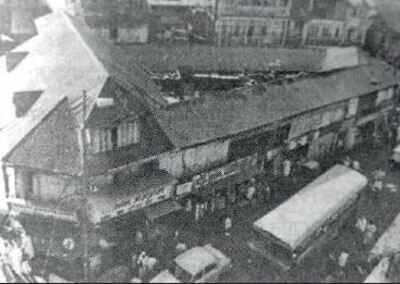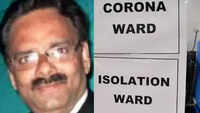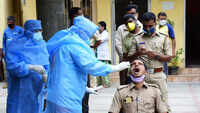
PUNE: Curbs on after-dark movement in the city that began on March 22 have gone on for nearly a 100 days. Stretched as it has been, the restriction is still nowhere near the longest period of ‘night curfew’ imposed in the city lasting 87 years from 1765 to 1852.
Cut to August 1791.
“The cannon at Bhamburda (now Shivajinagar) check post was fired at 9pm signalling a restriction (like today's night curfew) on the movement of people on the streets till the next morning. Unaware, 34 Brahmins, who had arrived in Pune from a city in the south, were roaming on the streets. They were arrested by the security guards and locked up in a small and congested room. When the doors were opened the next day, 21 of them had suffocated to death,” wrote noted history scholar late M P Mangudkar in his Marathi book Pune Nagarsanstha Shatabdi Grantha.
The book, an official documentation of the administrative history of Pune, was commissioned and published by the Pune Municipal Corporation in 1960.
Mangudkar wrote that the news of their deaths angered citizens who took out a protest march to the residence of Ghashiram Kotwal (then Pune's security chief).
“Ghashiram ran to the house of the Peshwa and begged for his intervention. However, he was handed over to the mob which stoned him to death on August 31, 1791,” he added in his book.
The chilling incident was first documented by Sir Charles Malet, a British officer who was visiting Pune in August 1791, in his despatches to London. Noted playwright Vijay Tendulkar in 1972 penned his powerful political satire 'Ghashiram Kotwal' based on this incident.
According to Mangudkar, the restriction on night movement was not Ghashiram’s idea, though he took it too far. Madhavrao Peshwa felt the need to set up an independent security agency to guard the city and introduced the system of kotwals in 1764, the author wrote.
The first kotwal or police chief of Pune, Balaji Narayan Ketkar, in 1765, started the practice of night patrol and imposed restrictions on the movement of people during the night hours.
Subsequent kotwals framed a series of rules, including making travel passes mandatory for night travel, and a collection of fines from those without a pass.
“Except for the tenure of Ghashiram, who was accused of high-handedness, most Punekars were happy with the kotwal system as it helped curb crime in the city. Two centuries ago, the dine-out culture and socialising avenues were limited,” history scholar Mandar Lawate told TOI.
Over the years, people became so used to the indoor life post sunset that when the British in 1850 proposed lifting of these restrictions, they resisted, arguing that it may lead to thefts across the city, he said.
“It took two years for the British to convince the citizens and get the restrictions removed in 1852,” Lawate added.
The current ban on night movement, between 9pm and 5am, has been the second longest in the history of Pune, according to the researcher. “The night curfew during the 1965 India-Pakistan war lasted for 10 days,” Lawate added.
The last footprint of the kotwal era, the historic Kotwal Chawdi, located 100m from the junction crossing Laxmi Road and Shivaji Road, faded into history when it was demolished by the Pune Municipal Corporation for road widening in 1995.
During the ten-day Ganeshotsav, lakhs of citizens visit the Dagdusheth Halwai Ganpati pandal, particularly during the late-night hours when it is brightly illuminated.
Many would not know that the pandal stands exactly on the spot vacated by Kotwal Chawdi. The place that was used for 87 years to prevent Punekars from stepping out during the nocturnal hours now sees the largest footfall at night during the festival.
Cut to August 1791.
“The cannon at Bhamburda (now Shivajinagar) check post was fired at 9pm signalling a restriction (like today's night curfew) on the movement of people on the streets till the next morning. Unaware, 34 Brahmins, who had arrived in Pune from a city in the south, were roaming on the streets. They were arrested by the security guards and locked up in a small and congested room. When the doors were opened the next day, 21 of them had suffocated to death,” wrote noted history scholar late M P Mangudkar in his Marathi book Pune Nagarsanstha Shatabdi Grantha.
The book, an official documentation of the administrative history of Pune, was commissioned and published by the Pune Municipal Corporation in 1960.
Mangudkar wrote that the news of their deaths angered citizens who took out a protest march to the residence of Ghashiram Kotwal (then Pune's security chief).
“Ghashiram ran to the house of the Peshwa and begged for his intervention. However, he was handed over to the mob which stoned him to death on August 31, 1791,” he added in his book.
The chilling incident was first documented by Sir Charles Malet, a British officer who was visiting Pune in August 1791, in his despatches to London. Noted playwright Vijay Tendulkar in 1972 penned his powerful political satire 'Ghashiram Kotwal' based on this incident.
According to Mangudkar, the restriction on night movement was not Ghashiram’s idea, though he took it too far. Madhavrao Peshwa felt the need to set up an independent security agency to guard the city and introduced the system of kotwals in 1764, the author wrote.
The first kotwal or police chief of Pune, Balaji Narayan Ketkar, in 1765, started the practice of night patrol and imposed restrictions on the movement of people during the night hours.
Subsequent kotwals framed a series of rules, including making travel passes mandatory for night travel, and a collection of fines from those without a pass.
“Except for the tenure of Ghashiram, who was accused of high-handedness, most Punekars were happy with the kotwal system as it helped curb crime in the city. Two centuries ago, the dine-out culture and socialising avenues were limited,” history scholar Mandar Lawate told TOI.
Over the years, people became so used to the indoor life post sunset that when the British in 1850 proposed lifting of these restrictions, they resisted, arguing that it may lead to thefts across the city, he said.
“It took two years for the British to convince the citizens and get the restrictions removed in 1852,” Lawate added.
The current ban on night movement, between 9pm and 5am, has been the second longest in the history of Pune, according to the researcher. “The night curfew during the 1965 India-Pakistan war lasted for 10 days,” Lawate added.
The last footprint of the kotwal era, the historic Kotwal Chawdi, located 100m from the junction crossing Laxmi Road and Shivaji Road, faded into history when it was demolished by the Pune Municipal Corporation for road widening in 1995.
During the ten-day Ganeshotsav, lakhs of citizens visit the Dagdusheth Halwai Ganpati pandal, particularly during the late-night hours when it is brightly illuminated.
Many would not know that the pandal stands exactly on the spot vacated by Kotwal Chawdi. The place that was used for 87 years to prevent Punekars from stepping out during the nocturnal hours now sees the largest footfall at night during the festival.

Coronavirus outbreak
Trending Topics
LATEST VIDEOS
City
 Delhi: Senior Covid frontline doctor falls to the virus, shockwaves among city’s medical fraternity
Delhi: Senior Covid frontline doctor falls to the virus, shockwaves among city’s medical fraternity  Delhi government to start 'plasma bank' for treatment of Covid-19 patients, says CM Arvind Kejriwal
Delhi government to start 'plasma bank' for treatment of Covid-19 patients, says CM Arvind Kejriwal  Covid-19: Journalist tests positive in Bengaluru, no contact tracing as yet
Covid-19: Journalist tests positive in Bengaluru, no contact tracing as yet  Covid-19 pandemic: Single-day spike of 19,459 cases takes India's tally to 5,48,318
Covid-19 pandemic: Single-day spike of 19,459 cases takes India's tally to 5,48,318
More from TOI
Navbharat Times
Featured Today in Travel
Quick Links
Kerala Coronavirus Helpline NumberHaryana Coronavirus Helpline NumberUP Coronavirus Helpline NumberBareilly NewsBhopal NewsCoronavirus in DelhiCoronavirus in HyderabadCoronavirus in IndiaCoronavirus symptomsCoronavirusRajasthan Coronavirus Helpline NumberAditya ThackerayShiv SenaFire in MumbaiAP Coronavirus Helpline NumberArvind KejriwalJammu Kashmir Coronavirus Helpline NumberSrinagar encounter
Get the app





